Tags:- Tramontina Kitchen Tools Catalogue
Brand :- Tramontina Kitchen Tools
Brand Category :- Home and Kitchen
To download PDF “Tramontina Kitchen Tools” Go Down on this Page
Check out the Video Catalogue
Tramontina Kitchen Tools
Example of Products manufactured By Tramontina Kitchen Tools
- Steak Knife
- Table Knife
- Table Fork
- Pizza Knife
- Table Spoon
- Chef Knife
- Dessert Knife
- Dessert Fork
- Dessert Spoon
- Mincing Knife
- Peeling Knife
- Kitchen Knife
- Paring Knife
- Ham Slicer
- Cold Cut Knife
- Sharpening Rod
- Carving Fork
- Oriental Cooks Knife
- Cake Molds
- Cast iron Pots and Pans
- Kitchen tools
- Etc.
Check out the Latest PDF Catalogue
Check out the latest Products By Tramontina Click on the Images to Find the Product , Features and Price with Availability
Buy this Brand Product Directly from your City ( Search the sellers of your city from below) || इस ब्रांड के उत्पाद को सीधे अपने शहर से खरीदें (नीचे से अपने शहर के विक्रेता खोजें)
Do You Sell this Brand Products ? || क्या आप इस ब्रांड के उत्पाद बेचते हैं ?
Register your self here (Fill the Form below) || यहां अपना पंजीकरण कराएं (नीचे दिया गया फॉर्म भरें)
All Registered Dealers Details will be shown on every Brand Page so that Customer can Contact You Directly || सभी पंजीकृत डीलरों का विवरण प्रत्येक ब्रांड पेज पर दिखाया जाएगा ताकि ग्राहक आपसे सीधे संपर्क कर सकें
Download Pdf Catalogue From The Link Below
CLICK HERE TO DOWNLOAD
Here are the different knives commonly used for culinary arts and the best job for each of them:
Chef’s Knife
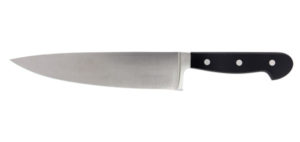
Chef’s knife
It’s right there in the name: The chef’s knife is one of the most frequently used and versatile tools in the kitchen. Chef’s knives are typically between 8 and 10 inches, although they can be as short as 6 inches and as long as 14 inches. You’ll use your chef’s knife for most of your slicing during food prep, and in many ways, it will be the most important tool you use.
Paring Knife
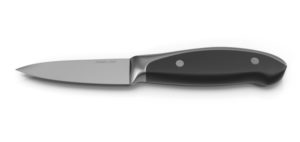
Paring knife
A paring knife is basically a small chef’s knife, and should be used for the same tasks on a smaller scale, especially those requiring more precision. Don’t use this kind of knife for any hard vegetables, since its light weight can cause you to use an unsafe amount of force. Paring knives are great for peeling, mincing and detailed cutting.
The blade will be no longer than 3.5 inches…ideal for detail work like creating a garnish. A paring knife is useful when you’re working with small or tender vegetables and fruit – ginger, strawberries, garlic, shallots – but isn’t suited for harder vegetables – carrots, beets, squash. You never want to apply force with a paring knife…choose a heavier blade for the harder tasks to avoid injury.
Utility Knife
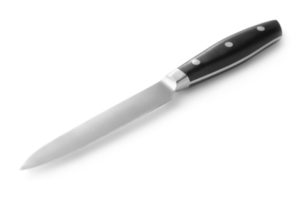
Utility knife
As the name suggests, this is a utilitarian knife – it does multi-duty. The blade is longer than a paring knife and more narrow than a chef’s knife. A utility knife is generally six inches long and works well slicing fruit, tender pieces of meat or sandwiches. The “knife of all trades,” it’s a handy go-to for the everyday chef.
Boning Knife
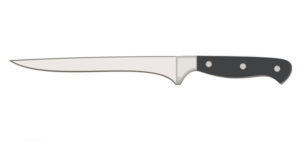
Boning Knife
Long, thin and strong, this knife is used to remove meat from the bone. Its thinness allows you to move with the curves and bends of the bone and separate the meat effectively, leaving as little behind as possible. When using a boning knife, do not attempt to cut through bones.
There are two versions of a boning knife, and both have a specific purpose. If you look at a chef’s knives, you’ll likely find both in their collection. A boning knife is narrow, comes to a very sharp point, and is usually five or six inches long. It will have either a flexible or stiff blade. The flexible blade is suitable for removing skin and bones from poultry and fish. The stiff blade allows the use of greater force when you’re working with thick cuts of meat like beef and pork.
Bread Knife
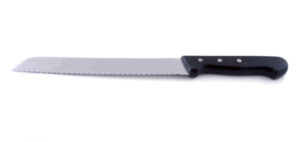
Bread knife
Once again, this knife’s name is not particularly subtle. The bread knife cuts through bread. Its serrated edge lets it slice bread without tearing the loaf apart.
The saw-like blade of a bread knife – or serrated knife – is ideal when you want to cut something without applying pressure. It’s great for gently slicing fresh bread, but also works well with soft fruits and vegetables, or ones that have a waxy surface. A serrated knife comes in handy when you’re slicing tomatoes, apples, citrus, or bell peppers. The sawing motion gently cuts through the surface without crushing the insides…though the cut won’t necessarily look as clean as the one you’ll get with a carving knife.
Keeping a bread knife sharp can be a challenge since you need a special tool to sharpen each surface of the jagged blade…but it’s worth the effort.
Carving Knife
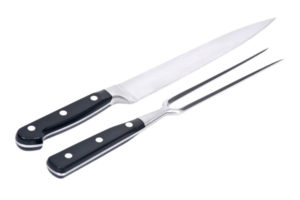
Carving knife
When you want a clean, precise cut, the carving knife is ideal. A good carving knife is usually fifteen inches long. Its thin blade, and indentation that stops food from sticking to the surface, make it the perfect choice when carving turkey, ham, pork or a beef roast. Whether you’re slicing a sirloin roast into paper-thin slices or a pork tenderloin into thick, juicy portions, a carving knife is the perfect tool.
Cheese knife
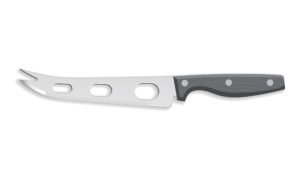
Cheese knife
Soft cheeses often stick to knives, which is why cheese knives have holes in them. These holes reduce the cheese’s surface contact with the knife, and cuts down on sticking. Be mindful of the sharpness of your knife when cutting cheese, as harder cheese will require a sharper knife.
Tomato knife
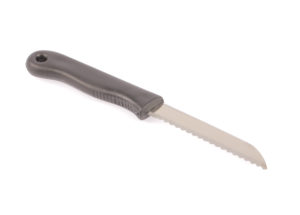
Tomato knife
Tomatoes are notoriously hard to slice because their skin is prone to tearing. Very small serrations on the tomato knife’s blade grip the skin of the tomato and reduce tears, allowing you to slice through easily.
Cleaver
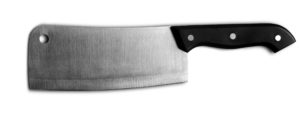
Cleaver
Cleavers are heavy, sharp knives used to cut through bones. Their size and weight help you drive them down through meat and bones, letting you prepare your meat yourself. While this knife isn’t particularly common in home kitchens, many chefs in restaurants use them, so they have total control over their cuts of meat.
While the chef’s knife reigns supreme in Western kitchens, The Kitchen claims that the cleaver is the most versatile knife in Chinese kitchens In addition to cutting through meat and bones, in China, they take the place of everything from a pairing knife to the chef’s. If you’re interested in investing in a cleaver, consider a Chinese-style one. These knives are lighter than their American counterparts, making them useful for many more kitchen tasks.
Mincing knife
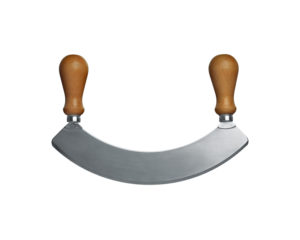
Mincing knife
A mincing knife is a curved knife that is held with both hands and used by rocking it back and forth. This knife can quickly mince vegetables or herbs into very small pieces with minimal effort.
Decorating knife
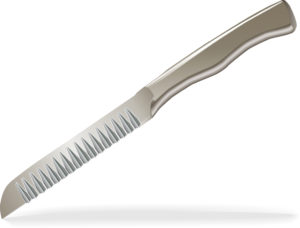
Decorating knife
If a chef wants his or her food to have a designed edge (for example, cut in a zig-zag pattern), he or she can use a decorating knife. Decorating knives have patterns in the blade that appear on the foods it cuts.
Keep Knives Sharp with a Honing Rod
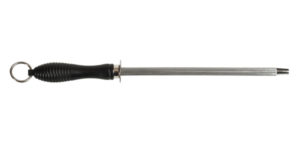
Honing Rod
It’s important to have the right knife for the job…but just as important to have the right tool to keep a sharp edge on your chef’s knives.


























